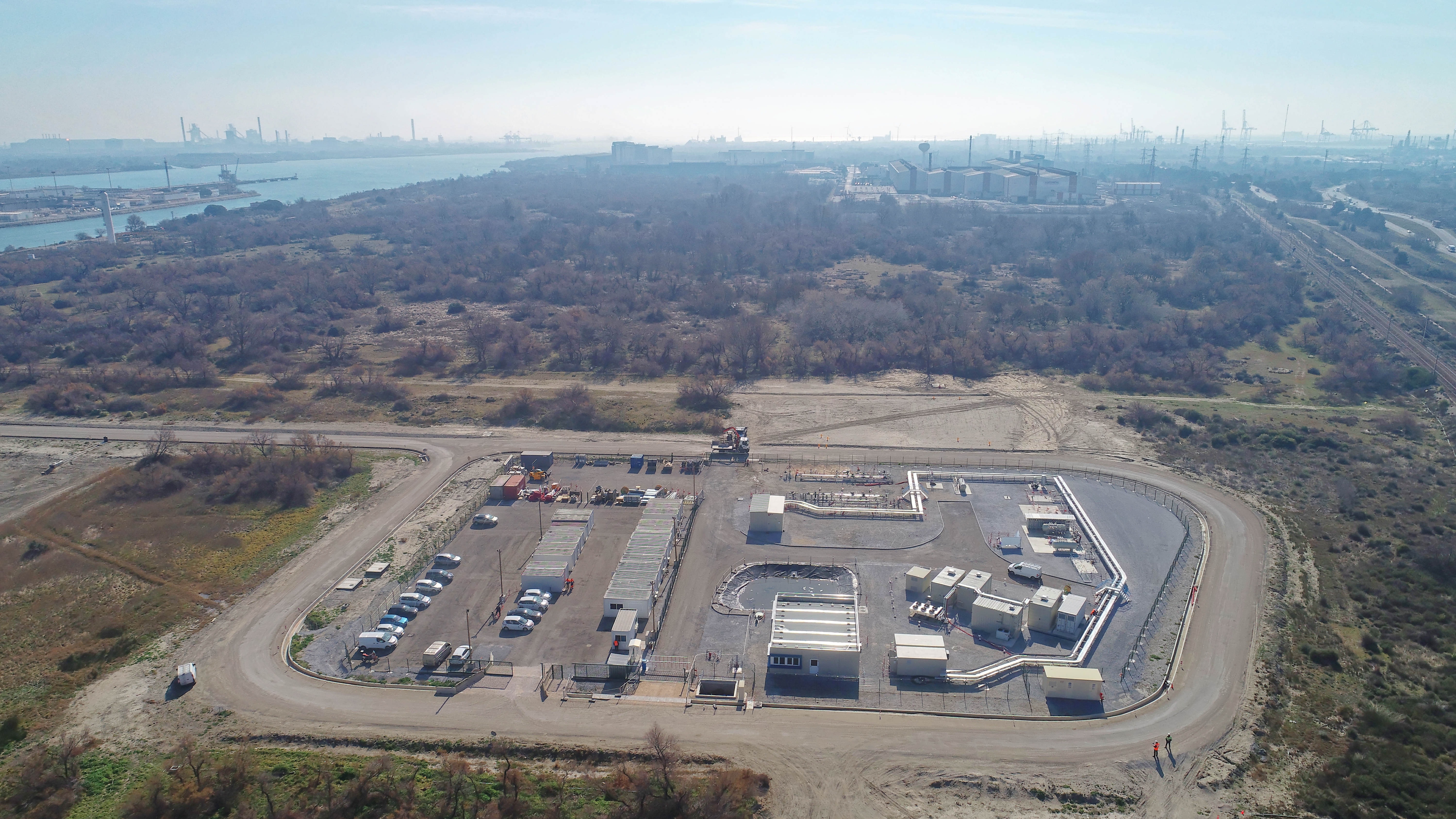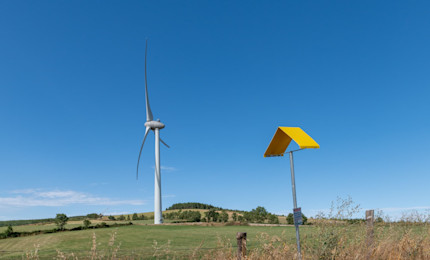Urgence gaz 0 800 028 800

The challenges of developing the hydrogen industry in Europe
Hydrogen’s potential is now foremost in everyone’s minds: as a direct solution for the decarbonisation of industry and transport, a source of reindustrialisation and local job creation, a lever for energy self-sufficiency, and more. William Rahain, business opportunities manager at Teréga’s Strategy & Innovation division, shines a light on the many challenges, both in France and across the whole of Europe.
Why is development of the hydrogen industry so central to the challenges of the energy transition?
William Rahain – the popularity and development of the hydrogen industry has many causes, because this issue lies at the very point where current expectations and questions collide. Firstly, it is a reflection of the global desire to respond to a strong, general expectation: to find the innovation that allows us to solve the issue of climate change.
Hydrogen is already a well-known gas, leading to a range of research activities with varying degrees of success in a world where oil reigns supreme. While it represents a market of 1 million tonnes in France, consumers are most often producers – mainly industry – and production is mostly carbonised (e.g. steam reforming of methane). Decarbonised hydrogen production technologies, too, are already familiar (electrolysis), even though they are still costly. But production costs should fall with its large-scale industrialisation. The attractiveness of hydrogen also resides in the potential for the reindustrialisation of France that it represents. Indeed, that large-scale industrialisation will allow us to reconquer the regions, create employment, relaunch the economy in low-carbon form, and establish France and Europe as the champions in this field.
The combination of those factors places hydrogen at the very heart of the energy transition, but there is more to it than that.
Our expert: biography
A graduate of the ENSGTI engineering school in Pau, William Rahain worked for some major international groups prior to joining Teréga in 2010. Having occupied various managerial posts in the Operations Department, in 2018 he became business opportunities manager at the Strategy & Innovation division. His specialisms: the rollout of hydrogen in France and Europe, Power-to-Gas, and multi-energy systems. As a result he was involved in the pilot phase of the Jupiter 1000 project, and has contributed his expertise to the implementation of the European Hydrogen Backbone and the Lacq Hydrogen and Hygéo projects.

At the French and European levels, what are the reasons behind the emergence of the hydrogen industry?
W.R. – In Europe, hydrogen has been a hot topic for four or five years, particularly in Germany, which has decided to halt its nuclear programme and move over to renewable electricity (solar, wind). Technically, experience has shown that this form of energy is harder to manage, due to the intermittent way in which the electricity is produced and the difficulty of storing it. An electricity grid supplied by renewable energies thus leads to losses: Germany alone has seen energy worth between 1 and 2 billion euro not being injected every year! So we need to find complementary alternatives, such as Power-to-Gas which enables us to capitalise on the excess electricity to produce hydrogen, which is easier to store and transport over long periods and over long distances.
Today in Europe, the main consumption focus for hydrogen as an energy carrier is therefore in Germany and the United Kingdom, because the energy mix of those two countries, and their main production of electricity, is based historically on carbon-heavy fossil fuels (coal), which need to be replaced if carbon neutrality targets are to be hit in 2050. The same movement is also starting to spread to Italy and Spain, where the energy mix is also fossil fuel based, but lower carbon.
In this area, France is an exception within Europe, because here the proportion of nuclear power is high. Our electricity is therefore already decarbonised and its production is not subject to the problems of intermittency.
Given its position as an exception in Europe, what is France’s position on the development of decarbonised hydrogen?
W.R. – In France, we are currently encouraging greater use of electricity, or the electrification of use, since this energy is already decarbonised. The consequence is that, nationally speaking, it is hydrogen-powered heavy transport which lies at the heart of the issue, because transport is the greatest emitter of CO2 (about 30%).
In 2018, a swing took place with the Hydrogen Plan introduced by Nicolas Hulot, then Minister for Ecological and Inclusive Transition, which allowed the integration of hydrogen as a form of energy, the inclusion of low-carbon hydrogen in the Long Term Energy Schedule (PPE) and approaches to the different energy infrastructure operators to study hydrogen’s integration into infrastructures. Following on from that, H2 was defined as a form of energy in the 2019 Energy and Climate law, and legislative work was launched through the Hydrogen Ordinance.
That willingness was reaffirmed at the end of 2020 with the presentation of a national roadmap and corresponding budget for the development of decarbonised hydrogen in France, as part of the European recovery plan. An ambitious investment strategy has been put in place to develop technologies producing decarbonised hydrogen by the electrolysis of water and to develop hydrogen-powered heavy vehicles (trains, aircraft, HGVs etc.).
France is therefore positioning itself at the forefront of the industrialisation of technologies. With the exception of transport, its use would tend to be elsewhere in industry. In Germany, mainly.
What are the usage challenges for the hydrogen industry in France?
W.R. – The main challenge for the hydrogen industry is finding uses, consumers and customers. Without customers, there is no market, hence no need for electrolysers and production plants.
This is a new energy form that needs more or less extensive adaptations to one’s equipment, be it a car or a boiler for a private citizen, a kiln or oven for an industrial customer, or a lorry or ship for a transporter. With the price of renewable hydrogen still being high, the additional cost of replacing one’s equipment, for a private or industrial customer, could be unthinkable or fatal.
However, opportunities to develop uses of hydrogen do exist in France. They are to be developed where local authorities and industries come together, so that each can benefit from the resulting synergies and economies of scale:
for industry: production and use of decarbonised hydrogen,
for local authorities: development of a new local transport arrangement, such as the conversion of vehicle fleets to hydrogen.
The issue of uses implies the production of decarbonised hydrogen at competitive prices. To reach that target, economies of scale are needed.
In France, last autumn, the government launched a public funding plan worth 7.2 billion euro to get the decarbonised hydrogen industry off the ground. Significantly, that included technologies for hydrogen production by the electrolysis of water, with a view to soon being able to offer low-carbon or renewable hydrogen at low cost.
So a number of industrial players are interested in the subject, whether from the production or consumption point of view. Heavy industry in particular, where not all processes can be electrified, sees it as an opportunity to decarbonise its activities. This is also the case in port areas, which need to find solutions for their decarbonisation.
On this point, refiners, but also actors in maritime and aeronautical activities, are also in the process of thinking about the creation of renewable or synthetic fuels produced from hydrogen (ethanol, synthetic kerosene)… That synthetic fuel could allow the decarbonisation of maritime and aeronautical activities, without the need to replace expensive ships and aircraft.
How can a grid operator such as Teréga participate in the rollout of the hydrogen industry?
W.R. – ~The issue of developing infrastructures to transport renewable hydrogen or of collaboration across the whole value chain are at the heart of the debate in Europe. Germany, for example, is aware that on its own it cannot satisfy its own decarbonised hydrogen needs. In 2020, it entered into agreements with Morocco and Tunisia on the development of renewable hydrogen production from their solar capacities.
But how is that hydrogen then transported in bulk to northern Europe? The transportation of liquefied hydrogen is possible by ship, but expensive, because you need to maintain a temperature of -260 °C (compared with -160 °C for LNG). The development of a piped transport grid would therefore be a real economic asset for the expansion of the whole hydrogen industry. If there is a reduction in the possible transport costs, there is an impact on the final cost to the consumer. In addition, the development of a European hydrogen grid will allow the creation of a real liquid market which will be very attractive to the big consumers.
Since 2014-2015 and our involvement in the Jupiter 1000 project, in partnership with NaTran – followed in 2019 by the inter-operator report on the technical and economic conditions for the integration of hydrogen into gas structures –, Teréga has been engaged in an active process on this issue, and particularly on the compatibility of our infrastructures with hydrogen. Because there lies the real challenge: how to adapt our transport and storage grid, our historic business, to play our part in this approach and encourage its development.

Aerial view of the Jupiter 100 Power-to-Gas demonstrator site at Fos-sur-Mer
As a result, we are involved in the Lacq Hydrogen project, the aim of which is to study how hydrogen can be transported and stored from Spain to France and, more specifically, to the Lacq Basin, where it will supply a 100% dispatchable renewable electricity generating plant. In fact, the countries of Southern Europe and North Africa have significant solar power production potential, which is favourable for the production of hydrogen by electrolysis at a competitive price. This is a first step toward the construction of a European hydrogen grid.
With hydrogen storage playing an essential role in resolving the problem of intermittency in solar and wind power, we have also instigated projects aimed at studying the opportunities for hydrogen storage in salt caverns (the Hygéo project), or to study its impact on our underground natural gas storage facilities (the RINGS project).
Finally, on a national level, we are working on a project to map those areas which are favourable for the injection of hydrogen into the natural gas network, to encourage the creation of local hydrogen initiatives.
In conclusion, how do you see the future of hydrogen and the industry as a whole?
W.R. – By 2050, to reach the carbon neutrality targets demanded by the ecological transition, natural gas will gradually be replaced by renewable and low-carbon gases: biomethane, synthetic methane, and decarbonised hydrogen. In view of that, Teréga and ten other European gas transporters presented a hydrogen plan in 2020 (updated in 2021) as part of the European strategy, aimed at creating a “hydrogen backbone”. That approach could enable Europe to achieve carbon neutrality in 2050, drawing on the existing gas infrastructures.
The report on the Hydrogen Backbone vision foresees, for 2040, a network extending to about 40,000 km, linking 21 European countries, with almost 70% of existing gas pipelines converted.
In addition, Teréga is involved in the HyDeal Ambition project, alongside about thirty industry stakeholders, foreshadowing the future European hydrogen industry. The ambition: to provide green hydrogen at a competitive price of €1.50/kg, close to the price of fossil fuels.
That process is the result of two years of studies and preparation with an ambitious target: from 2022, to produce green hydrogen from the electrolysis of water, using solar energy from the Iberian Peninsula. The stated ambition for 2030 is to provide 3.6 million tonnes of hydrogen per year to the energy, industry and transport sectors, via gas transport and storage infrastructures.
Finally, hydrogen will develop in parallel with other renewable energies, thus creating a low-carbon energy mix which is more diversified and more local. To that end, gas transport and storage grids are evolving into multi-energy grids, resorting to new intelligence in managing the coexistence of the different energy sources in the energy mix, as seen in Teréga’s IMPULSE 2025 project. As part of that, and as a benchmark energy carrier, hydrogen will be a determining element in multi-energy systems.









